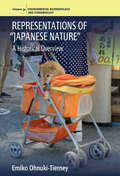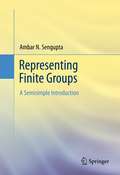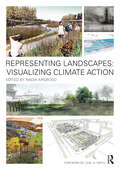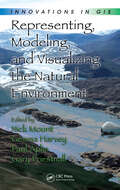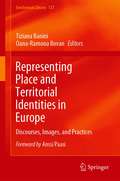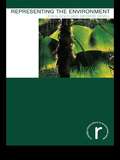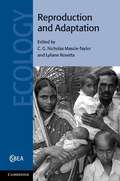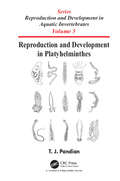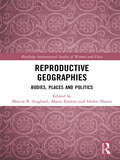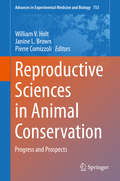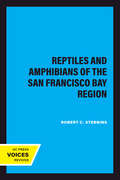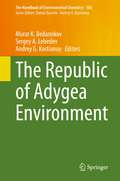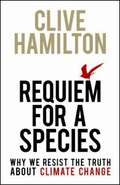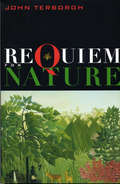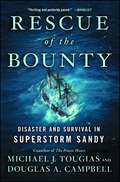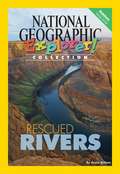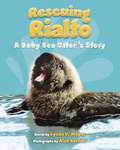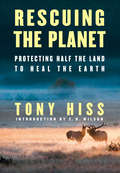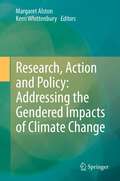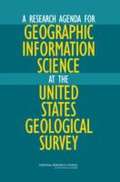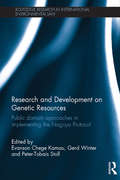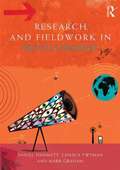- Table View
- List View
Representations of “Japanese Nature”: A Historical Overview (Environmental Anthropology and Ethnobiology)
by Emiko Ohnuki-Tierney“Nature” as a concept and word is extremely elusive, yet it is commonly taken for granted that “the pristine nature” is “out there.” This book explores the factors that have naturalized the idea of nature as “pristine” into our psyche, and as something that has a spatial, visual, and temporal dimension for “seasons”. Much emphasis is given to the inhabitants demonstrating the dynamic characteristic of nature. As a study done over a long period of history, Representations of “Japanese Nature” shows the mutual support between conceptual principles of nature and the daily activities of the people .
Representing Finite Groups
by Ambar N. SenguptaThis graduate textbook presents the basics of representation theory for finite groups from the point of view of semisimple algebras and modules over them. The presentation interweaves insights from specific examples with development of general and powerful tools based on the notion of semisimplicity. The elegant ideas of commutant duality are introduced, along with an introduction to representations of unitary groups. The text progresses systematically and the presentation is friendly and inviting. Central concepts are revisited and explored from multiple viewpoints. Exercises at the end of the chapter help reinforce the material. Representing Finite Groups: A Semisimple Introduction would serve as a textbook for graduate and some advanced undergraduate courses in mathematics. Prerequisites include acquaintance with elementary group theory and some familiarity with rings and modules. A final chapter presents a self-contained account of notions and results in algebra that are used. Researchers in mathematics and mathematical physics will also find this book useful. A separate solutions manual is available for instructors.
Representing Landscapes: Visualizing Climate Action (Representing Landscapes)
by Nadia AmorosoThis book provides an in-depth overview of graphic and visual communication styles for conveying climate change and climate action within the landscape architectural profession and in academia. The book features visualizations of climate adaptation and resilience, developed by award-winning landscape architects and academics from Canada, the United States, the United Kingdom, The Netherlands, Denmark, Germany, Italy, France, Finland, South Africa, Singapore, and China. Representing Landscapes: Visualizing Climate Action illustrates the imaginative ways in which climate action and climate resilient concepts are visually presented, communicated, and perceived. The book will be especially valuable for students and practitioners in landscape architecture, urban planning, and related fields to understand how to visually capture climate change issues and design solutions, and to deliver this message to the public.
Representing, Modeling, and Visualizing the Natural Environment (Innovations in GIS)
by Nick Mount Gemma Harvey Paul Aplin Gary PriestnallThe explosion of public interest in the natural environment can, to a large extent, be attributed to greater public awareness of the impacts of global warming and climate change. This has led to increased research interest and funding directed at studies of issues affecting sensitive, natural environments. Not surprisingly, much of this work has re
Representing Place and Territorial Identities in Europe: Discourses, Images, and Practices (GeoJournal Library #127)
by Tiziana Banini Oana-Ramona IlovanThis book provides insight into the topic of place and territorial identity, which involves both the dimension of collective belonging and the politics of territorial planning and enhancement. It considers the social, economic and political effects of territorial identity representations among others in terms of mystification, spatial fetishism, and the creation of place and territorial stereotypes. A mixed methodology is employed to research case studies at diverse territorial scales which are relevant to the impact of a variety of factors on place/territorial identity processes such as migration, political and economic changes, natural disasters, land use changes, etc. Visual imagery, constructing visual discourses and living within visual cultures are placed in the foreground and refer to among others the changes and challenges introduced by the Internet and social networks in place/territory representations and self-representations; identity politics and its impact on place/territorial identity representations; discourses in shaping representations and self-representations of territorial/place-based identities related to collective memory, cultural heritage, invented tradition, imagined communities and other key notions.
Representing the Environment (Routledge Introductions to Environment: Environment and Society Texts)
by John R. Gold George RevillThe development of the environmental movement has relied heavily upon written and visual imagery. Representing the Environment offers an introductory guide to representations of the environment found in the media, literature, art and everyday life encounters. Featuring case studies from Europe, the Americas and Australia, Representing the Environment provides practical guidance on how to study environmental representations from a cultural and historic perspective, and places the reader in the role of active interpreter. The book argues that studying representations provides an important lens on the development of environmental attitudes, values and decision-making.
Reproduction and Adaptation
by C. G. Mascie-Taylor Lyliane RosettaIn the space of one generation major changes have begun to take place in the field of human reproduction. A rapid increase in the control of fertility and the understanding and treatment of sexual health issues have been accompanied by an emerging threat to reproductive function linked to increasing environmental pollution and dramatic changes in lifestyle. Organised around four key themes, this book provides a valuable review of some of the most important recent findings in human reproductive ecology. Major topics include the impact of the environment on reproduction, the role of physical activity and energetics in regulating reproduction, sexual maturation and ovulation assessment and demographic, health and family planning issues. Both theoretical and practical issues are covered, including the evolution and importance of the menopause and the various statistical methods by which researchers can analyse characteristics of the menstrual cycle in field studies.
Reproduction and Development in Platyhelminthes (Reproduction and Development in Aquatic Invertebrates)
by T. J. PandianThis book is a comprehensive elucidation on aspects of reproduction and development in platyhelminthes covering from acoelids to taeniids. With the unique presence of neoblasts, turbellarians serve as a model for studies on cancer and senescence. Of ~ 27,000 species, ~ 77% are parasites; they are harmful to man and his food basket from livestock and fish. The stress hormone, cortisol level is responsible for susceptibility and resistance of the host. In digeneans, the propagatory multiplication potency is retained by all the larval forms and in either direction in sporocyst. The higher clonal diversity, mixing and selection in Second Intermediate Host (SIH) may purge inbreeding depression suffered by the fluke on propagatory multiplication in First Intermediate Host (FIH). Of 12,012 digeneans, 88% may engage 33,014 potential SIH species. They have the choice to select one among the available/awaiting 3.5 host species. The motility of vertebrate host and euryxenic flexibility/scope for selection of SIH species has increased lineage diversification in digeneans. The life cycle of cestodes is divided into aquatic and terrestrial patterns. The former includes (i) oncosphere and (ii) coracidium types and the latter (iii) hexacanth-cysticercoid, (iv) hexacanth-tetrathyridium and (v) hexacanth-cysticercus types. The share for the oncosphere, coracidium and hexacanth types is 17.0, 29.5 and 46.5%, respectively. The staggering fecundity and adoption of the intermediate host in the herbivorous/insectivorous food chain have enriched Taenioidea as the most (2,264) speciose order. Sex specific genes Smed-dmd 1 and macbol have been identified, and neuropeptides and dipeptides are involved in sexualization. Trematodes are unable to parasitize elasmobranchs, as they cannot suck body fluid/blood containing a high level of urea. Relatively higher fecundity supplemented with propagatory multiplication, incorporation of SIH in 88% species, clonal selection in SIH, and euryxenic flexibility and the widest choice for selection of SIH have led to the highest lineage diversification to render digeneans as the most speciose order in Platyhelminthes.
Reproductive Geographies: Bodies, Places and Politics (Routledge International Studies of Women and Place)
by Marcia R. England Maria Fannin Helen HazenThe sites, spaces and subjects of reproduction are distinctly geographical. Reproductive geographies span different scales - body, home, local, national, global - and movements across space. This book expands our understanding of the socio-cultural and spatial aspects of fertility, pregnancy and birth. The chapters directly address global perspectives, the future of reproductive politics and state-focused approaches to the politicisation of fertility, pregnancy and birth. The book provides up-to-date explorations on the changing landscapes of reproduction, including the expansion of reproductive technologies, such as surrogacy and intrauterine insemination. Contributions in this book focus on phenomenologically-inspired accounts of women’s lived experience of pregnancy and birth, the biopolitics of birth and citizenship, the material histories of reproductive tissues as "scientific objects" and engagements with public health and development policy. This is an essential resource for upper-level undergraduates and graduates studying topics such as Sociology, Geographies of Gender, Women’s Studies and Anthropology of Health and Medicine.
Reproductive Sciences in Animal Conservation
by William V. Holt Janine L. Brown Pierre ComizzoliReproductive biology is more than the development of techniques for helping with too little or too much breeding. While some of the relevant techniques are useful for individual species, technical developments have to be backed up by thorough biological understanding of the background behind the problems. This book is therefore threefold; (1) it provides a snapshot of the state of the art in terms of species-specific reproductive technologies, whether for individual animals or whole taxonomic groups; (2) it sets the reproductive problems in context and emphasizes the links between animal-based problems and the wider world, e. g. reproductive fitness and (3) it looks forward and presents realistic assessments of how effective some of the more recently developed techniques in reproductive technology might be at combating extinctions. This is a wide-ranging book that will be relevant to anyone involved in reproductive biology or in species conservation and provides provide them some useful perspectives about the real utility of current and emerging technologies. It has contributions from experts in reproduction and related fields.
Reptiles and Amphibians of the San Francisco Bay Region (California Natural History Guides #3)
by Robert C. StebbinsThis title is part of UC Press's Voices Revived program, which commemorates University of California Press’s mission to seek out and cultivate the brightest minds and give them voice, reach, and impact. Drawing on a backlist dating to 1893, Voices Revived makes high-quality, peer-reviewed scholarship accessible once again using print-on-demand technology. This title was originally published in 1959.This title is part of UC Press's Voices Revived program, which commemorates University of California Press’s mission to seek out and cultivate the brightest minds and give them voice, reach, and impact. Drawing on a backlist dating to 1893, Voices Revived</DIV
The Republic of Adygea Environment (The Handbook of Environmental Chemistry #106)
by Murat K. Bedanokov Sergey A. Lebedev Andrey G. KostianoyThis book outlines the current status of the environment in the Republic of Adygea in Russia. The book assesses the environmental conditions, ecological state, climate and vegetation change, anthropogenic loads to soil, water and atmosphere as well as highlighting the potential of water resources, renewable energy and development of tourism, agriculture and industry in this region. It also presents the mechanisms of legal, ecological and economic regulation and environmental insurance in the Republic of Adygea. This book introduces the Republic of Adygea to readers who are not familiar with the Republic and its beautiful landscapes, history and people. It offers a valuable source of information for a broad readership, from students and scientists interested in environmental sciences, to policymakers and practitioners working in the fields of environmental policy and management.
The Republican Reversal: Conservatives and the Environment from Nixon to Trump
by James Morton TurnerNot long ago Republicans took pride in their tradition of environmental leadership. The GOP helped create the EPA, extend the Clean Air Act, and protect endangered species. Today Republicans denounce climate change as a “hoax” and seek to dismantle environmental regulations. What happened? James Morton Turner and Andrew C. Isenberg provide answers.
Requiem for a Species: Why We Resist the Truth About Climate Change
by Clive HamiltonClive Hamilton offers a compelling description of a world transformed by climate change and explains why we won't stop climate change even though we know it will destroy us. This book does not set out to raise the alarm again to encourage us to take radical measures to head off climate chaos. There have been many books and reports in recent years explaining just how dire the future looks and how little time we have left to act. This book is about why we have ignored those warnings, and why it may now be too late. It is a book about the frailties of the human species as expressed in both the institutions we built and the psychological dispositions that have led us on the path of self-destruction. It is about our strange obsessions, our hubris, and our penchant for avoiding the facts. It is the story of a battle within us between the forces that should have caused us to protect the Earth, "our capacity to reason and our connection to Nature "and those that, in the end, have won out "our greed, materialism and alienation from Nature. And it is about the 21st century consequences of these failures.
Requiem for Nature
by John TerborghFor ecologist John Terborgh, Manu National Park in the rainforest of Peru is a second home; he has spent half of each of the past twenty-five years there conducting research. Like all parks, Manu is assumed to provide inviolate protection to nature. Yet even there, in one of the most remote corners of the planet, Terborgh has been witness to the relentless onslaught of civilization.Seeing the steady destruction of irreplaceable habitat has been a startling and disturbing experience for Terborgh, one that has raised urgent questions: Is enough being done to protect nature? Are current conservation efforts succeeding? What could be done differently? What should be done differently? In Requiem for Nature, he offers brutally honest answers to those difficult questions, and appraises the prospects for the future of tropical conservation. His book is a clarion call for anyone who cares about the quality of the natural world we will leave our children.Terborgh examines current conservation strategies and considers the shortcomings of parks and protected areas both from ecological and institutional perspectives. He explains how seemingly pristine environments can gradually degrade, and describes the difficult social context -a debilitating combination of poverty, corruption, abuses of power, political instability, and a frenzied scramble for quick riches -in which tropical conservation must take place. He considers the significant challenges facing existing parks and examines problems inherent in alternative approaches, such as ecotourism, the exploitation of nontimber forest products, "sustainable use," and "sustainable development."Throughout, Terborgh argues that the greatest challenges of conservation are not scientific, but are social, economic, and political, and that success will require simultaneous progress on all fronts. He makes a compelling case that nature can be saved, but only if good science and strong institutions can be thoughtfully combined.
The Rescue Effect: The Key to Saving Life on Earth
by Michael Mehta Webster&“Details profound examples of life&’s resilience and makes a convincing case that the natural world still has a lot worth fighting for.&” —Paul Greenberg, New York Times bestselling author of Four Fish and The Climate Diet As climate change continues to intensify, the outlook for life on Earth often seems bleak. Yet hope for the future can be found in the &“rescue effect,&” which is nature&’s innate ability to help organisms persist during hard times. Like a thermostat starting the air conditioning when a room gets too warm, the rescue effect automatically kicks in when organisms are stressed or declining. In The Rescue Effect, Michael Mehta Webster reveals the science behind nature&’s inherent resilience, through compelling stories of species that are adapting to the changing world—including tigers in the jungles of India, cichlid fish in the great lakes of Africa, and corals in the Caribbean. In some cases, like the mountain pygmy-possum in the snowy mountains of southeast Australia, we risk losing species without intensive help from people. As observers to—and the cause of—species declines, we must choose whether and how to help, while navigating challenging questions about emerging technologies and the ethics of conservation actions. Ultimately, Webster argues that there are good reasons to expect a bright future, because everywhere we look, we can see evidence that nature can rescue many species from extinction; and when nature alone is not up to the task, we can help. Combining rigorous research with gripping storytelling, The Rescue Effect provides the cautious optimism we need to help save life on Earth.
Rescue of the Bounty: Disaster and Survival in Superstorm Sandy (True Rescue Ser.)
by Michael J. Tougias Douglas A. CampbellFrom the author of the Fall 2015 Disney movie The Finest Hours, the “thrilling and perfectly paced” (Booklist) story of the sinking and rescue of Bounty—the tall ship used in the classic 1962 movie Mutiny on the Bounty—which was caught in the path of Hurricane Sandy with sixteen aboard.On Thursday, October 25, 2012, Captain Robin Walbridge made the fateful decision to sail Bounty from New London, Connecticut, to St. Petersburg, Florida. Walbridge knew that a hurricane was forecast, yet he was determined to sail. The captain told the crew that anyone could leave the ship before it sailed. No one took the captain up on his offer. Four days into the voyage, Superstorm Sandy made an almost direct hit on the ship. A few hours later, the ship suddenly overturned ninety miles off the North Carolina coast in the “Graveyard of the Atlantic,” sending the crew tumbling into an ocean filled with towering thirty-foot waves. The coast guard then launched one of the most complex and massive rescues in its history. In the uproar heard across American media in the days following, a single question persisted: Why did the captain decide to sail? Through hundreds of hours of interviews with the crew members and the coast guard, Michael J. Tougias and Douglas A. Campbell create an in-depth portrait of the enigmatic Captain Walbridge, his motivations, and what truly occurred aboard Bounty during those terrifying days at sea. “A white-knuckled, tragic adventure” (Richmond Times-Dispatch), Rescue of the Bounty is an unforgettable tale about the brutality of nature and the human will to survive.
Rescuing Rialto: A Baby Sea Otter's Story
by Lynda V. Mapes"Calling all sea otter fans!" - KirkusOn a sunny August morning in 2016, a baby sea otter was found washed up on the sand. Orphaned and sick, Rialto was taken to the Seattle Aquarium, where his dedicated caretakers nursed him back to health and taught him how to be an otter. Soon, the charming Rialto was stealing hearts as he played with toys made of ide, swam in his very own pool, ate tasty clams, and floated on his back. Learn about the rescue--and how you can help to save this endangered species--in Rescuing Rialto, from the Seattle Times reporter and photographer who chronicled this story as it happened. Just as he captured them, Rialto's sure to steal your heart, too.
Rescuing the Planet: Protecting Half the Land to Heal the Earth
by Tony Hiss"As clear a picture of humanity's impact on earth's natural environment as any ever written." --E. O. Wilson (from the Introduction)An urgent, resounding call to protect 50 percent of the earth's land by 2050--thereby saving millions of its species--and a candid assessment of the health of our planet and our role in conserving it, from the award-winning author of The Experience of Place and veteran New Yorker staff writer.Beginning in the vast North American Boreal Forest that stretches through Canada, and roving across the continent, from the Northern Sierra to Alabama's Paint Rock Forest, from the Appalachian Trail to a ranch in Mexico, Tony Hiss sets out on a journey to take stock of the "superorganism" that is the earth: its land, its elements, its plants and animals, its greatest threats--and what we can do to keep it, and ourselves, alive.Hiss not only invites us to understand the scope and gravity of the problems we face, but also makes the case for why protecting half the land is the way to fix those problems. He highlights the important work of the many groups already involved in this fight, such as the Indigenous Leadership Initiative, the Yellowstone to Yukon Conservation Initiative, and the global animal tracking project ICARUS. And he introduces us to the engineers, geologists, biologists, botanists, oceanographers, ecologists, and other "Half Earthers" like Hiss himself who are allied in their dedication to the unifying, essential cause of saving our own planet from ourselves.Tender, impassioned, curious, and above all else inspiring, Rescuing the Planet is a work that promises to make all of us better citizens of the earth.
Research, Action and Policy: Addressing the Gendered Impacts of Climate Change
by Kerri Whittenbury Margaret AlstonResearch, Action and Policy: Addressing the Gendered Impacts of Climate Change presents the voices of women from every continent, women who face vastly different climate events and challenges. The book heralds a new way of understanding climate change that incorporates gender justice and human rights for all.
A Research Agenda For Geographic Information Science At The United States Geological Survey
by National Research Council of the National AcademiesComprehensive and authoritative baseline geospatial data content is crucial to the nation and to the U.S. Geological Survey (USGS). The USGS founded its Center of Excellence for Geospatial Information Science (CEGIS) in 2006 to develop and distribute national geospatial data assets in a fast-moving information technology environment. In order to fulfill this mission, the USGS asked the National Research Council to assess current GIScience capabilities at the USGS, identify current and future needs for GIScience capabilities, recommend strategies for strengthening these capabilities and for collaborating with others to maximize research productivity, and make recommendations regarding the most effective research areas for CEGIS to pursue. With an initial focus on improving the capabilities of The National Map, the report recommends three priority research areas for CEGIS: information access and dissemination, data integration, and data models, and further identifies research topics within these areas that CEGIS should pursue. To address these research topics, CEGIS needs a sustainable research management process that involves a portfolio of collaborative research that balances short and long term goals.
Research and Development on a Salt Processing Alternative for High-level Waste at the Savannah River Site
by Committee on Radionuclide Separation Processes for High-level Waste at the Savannah River SiteThe National Academies Press (NAP)--publisher for the National Academies--publishes more than 200 books a year offering the most authoritative views, definitive information, and groundbreaking recommendations on a wide range of topics in science, engineering, and health. Our books are unique in that they are authored by the nation's leading experts in every scientific field.
Research and Development on Genetic Resources: Public Domain Approaches in Implementing the Nagoya Protocol (Routledge Research in International Environmental Law)
by Gerd Winter Peter-Tobias Stoll Evanson Chege KamauNational implementation of the Convention on Biological Diversity (CBD) provisions has yielded enough challenges for providers and users of genetic resources and associated traditional knowledge alike. The Nagoya Protocal brings novel ideas for resolving the challenges plaguing the Access and Benefit-Sharing (ABS) process in general and non-commercial research in particular. This is one of the first books to address research cooperation and facilitated access for non-commercial biodiversity research. It uniquely offers concrete and practicable solutions based on experiences of researchers and administrative officials with ABS, and on the interpretation of the Nagoya Protocol on how free and lively taxonomic research can be ensured while at the same time observing obligations of obtaining prior informed consent and sharing of benefits. This book will be useful to students of International Environmental Law, International Biodiversity Law, Intellectual Property Law, Climate Law and Law of Indigenous Populations. With foreword from Executive Secretary CBD, Braulio Ferreira de Souza Dias.
Research and Fieldwork in Development
by Daniel Hammett Chasca Twyman Mark GrahamResearch and Fieldwork in Development explores both traditional and cutting edge research methods, from interviews and ethnography to spatial data and digital methods. Each chapter provides the reader with an understanding of the theoretical basis of research methods, reflects upon their practice and outlines appropriate analysis techniques. The text also provides a cutting edge focus on the role of new media and technologies in conducting research. The final chapters return to a set of broader concerns in development research, providing a new and dynamic set of engagements with ethics and risk in fieldwork, integrating methods and engaging development research methods with knowledge exchange practices. Each chapter is supported by several case studies written by global experts within the field, documenting encounters and experiences and linking theory to practice. Each chapter is also complimented by an end of chapter summary, suggestions for further reading and websites, and questions for further reflection and practice. The text critically locates development research within the field of international development to give an accessible and comprehensive introduction to development research methods. This book provides an invaluable overview to the practice of international development research and serves as an essential resource for undergraduate and postgraduate student embarking of development fieldwork. It is supported by online resources including extended bibliographies for each chapter, example risk and ethic forms, example policy briefing notes, research reports, links to websites and data sources.
